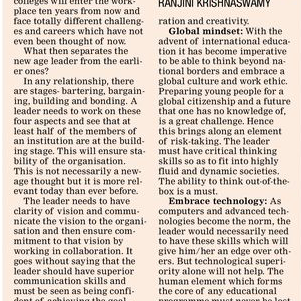The leader needs to have clarity of vision and communicate the vision to the organisation and then ensure commitment to that vision by working in collaboration.
A quarter of a century ago, life was simple and uncomplicated. Careers too were not as varied and most young people just drifted into a profession. The scenario today is totally different, right from pre-school, plans are being drawn up and careers plotted to the minutest detail by anxious parents. Changes in the academic arena are, however, slow to manifest themselves. What we need is a radical change in the mindset of parents, because the pupils who are currently in schools and colleges will enter the workplace ten years from now and face totally different challenges and careers which have not even been thought of now.
What then separates the new age leader from the earlier ones?
In any relationship, there are stages- bartering, bargaining, building and bonding. A leader needs to work on these four aspects and see that at least half of the members of an institution are at the building stage. This will ensure stability of the organisation. This is not necessarily a new-age thought but it is more relevant today than ever before.
The leader needs to have clarity of vision and communicate the vision to the organisation and then ensure commitment to that vision by working in collaboration. It goes without saying that the leader should have superior communication skills and must be seen as being confident of achieving the goal.
Team Player: The days of a single leader leading a team is over. Instead, we have leaders emerging depending on the situation and true leaders are those that walk along with their team and not in front of them.
Multi-tasker: No where is this more important as it is in schools. The school head is a teacher, mentor, agony aunt, subject specialist, administarator, counsellor, HR person all rolled into one. Above all, the teacher needs to be able to manage time, space, resources and people.
Networking: The leader today needs to know a host of people and know them well. This involves constant interaction, keeping in touch and maintaining visibility, all of which are needed for collaboration and creativity.
Global mindset: With the advent of international education it has become imperative to be able to think beyond national borders and embrace a global culture and work ethic. Preparing young people for a global citizenship and a future that one has no knowledge of, is a great challenge. Hence this brings along an element of risk-taking. The leader must have critical thinking skills so as to fit into highly fluid and dynamic societies. The ability to think out-of-the-box is a must.
Embrace technology: As computers and advanced technologies become the norm, the leader would necessarily need to have these skills which will give him/her an edge over others. But technological superiority alone will not help. The human element which forms the core of any educational programme must never be lost sight of.
Motivation followed by mentoring will send a clear message right across the institution as well as the public involved that here is a definite plan. This gives a sense of security and stability to the institution. All this can happen only if the leader has a high level of emotional quotient or security (both personal and professional). Of course it goes without saying that along with the qualities mentioned above, a leader needs to walk the talk. This sends a clear signal that he/she can, will and is able to do all that is expected from the rest of the team. Only then will the leader earn the respect.
Author: Dr. Ranjini Krishnaswamy
Email: jinikay@gmail.com
This Article was published in the DNA Newspaper (Mumbai Edition) on 16th March 2017. You can read it here.





